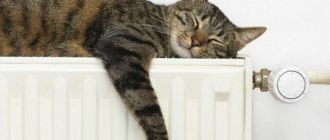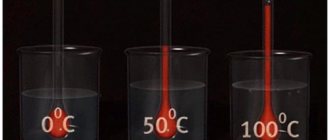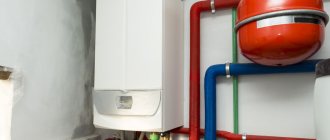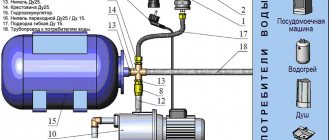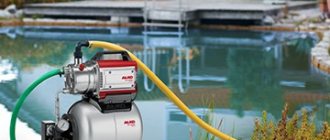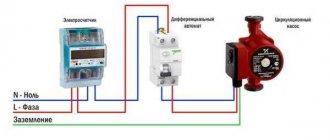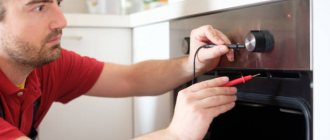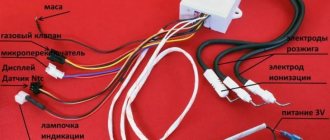The working volume of coolant in the heating network may decrease due to a number of reasons - leakage, evaporation, steam discharge through an automatic valve, repair work. In an open type scheme, the main riser is emptied and filled with air from the expansion tank; when closed, the pressure is significantly reduced. In any case, the heating system needs to be recharged, which can be done in several ways.
Why do you have to add water to the system?
For the boiler to work correctly, it is necessary to maintain the recommended pressure in the system. Obviously, for this to happen, a constant volume of coolant must circulate in the water heating system. And it can change during operation even in a perfectly designed and assembled structure. Loss of coolant occurs when:
- The air is bleed through the Mayevsky valve located on the radiator. As you know, you have to open the air vent and wait until a trickle of water comes out of it.
- In automatic mode, excess pressure is released through a safety valve due to a change in the operating mode of the system. In this case, the coolant escapes into the atmosphere in a gaseous state.
- The filters are cleaned from mechanical contaminants.
- There are significant or microscopic leaks, for example through dismountable connections.
- In systems with natural circulation, water evaporates through an open expansion tank.
Solving ventilation problems
The reason why a gas boiler does not turn on is often hidden in the ventilation system. This is especially true for models with an open camera. Since there will be no flame without an influx of oxygen from outside.
What you need to do: think about the ventilation in the room. Install special valves on the windows or simply open them.
If the gas boiler does not heat water, check if there is draft. Light a match and bring it to the window or outlet. When everything is in order with the draft, the flame tends to the side. If there is a problem, it burns straight. We need a chimney inspection.
How recharge works
The main task of the make-up unit is to add the missing coolant to the heating system until the operating pressure returns to normal. In most cases, heating make-up is connected to a cold water supply, but the system can also be powered from a storage tank. There are two ways to replenish the coolant volume.
- Manual mode. It is usually used in small systems. The user himself periodically monitors the pressure using the pressure gauge and, when necessary, opens the appropriate taps. Water flows by gravity, or a make-up pump is used for heating. In the simplest gravity installations, water is collected until it comes out of an overflow pipe welded to the expansion tank.
- Automatic recharge of the heating system. If the pressure in the system drops below the set value, the heating system feed valve (or electric valve/valve) is activated, which opens the flow hole. If necessary, voltage is applied in parallel to the sediment, and water will begin to forcefully enter the system. When the pressure readings return to normal, the valve will close and the pumping equipment will turn off. Sometimes the power supply is part of the heat generator. The advantage of using automation is that there is no need to engage in control; everything happens without the participation of the homeowner. The disadvantage is the fact that another element appears in the circuit that needs power supply.
Note that this unit is used not only for adding water during operation. Through it the following is carried out:
- initial filling of coolant into the system;
- complete discharge of water (for example, for repairs);
- water preparation (coarse filtration, softening);
- flushing the system;
- crimping.
Finally, about the safe addition of coolant
When filling water or partial replenishment, follow our recommendations:
- Replenish the heated system slowly by opening the valve a quarter of the lever stroke. In this way, it will be possible to avoid the formation of air locks and protect the boiler heat exchanger from temperature shock.
- Refill from scratch with the heat generator not working and the circulation pump turned off.
- Check the pressure in the expansion tank and go through all the radiators, opening the Mayevsky valves to release air.
- If your boiler is equipped with modern electronics, be sure to study the instructions regarding make-up. Often it is necessary to activate a special service mode in the unit.
- Excess pressure is easily released through the nearest air vent.
The complex system make-up module can be connected to a hydraulic separator and a comb
Reference. Cast iron heat exchangers easily crack from sudden temperature changes, and steel fireboxes become covered from the inside with condensation. The latter mixes with soot and forms a dense coating.
Injecting antifreeze with a hand pump does not have any pitfalls. Pressure testing units are equipped with their own pressure gauge, which allows you to monitor the current pressure at the insertion point.
Let's consider the reasons why the pressure in a double-circuit boiler can constantly increase (or rather, increase until the pressure relief valve in the boiler operates). Considering that the operating principle of most boilers is similar, this malfunction can manifest itself in various models: Baxi, Ariston, Buderus, etc.
When the pressure in a double-circuit gas boiler drops, this is somehow understandable, but when the pressure itself increases! However, this is exactly what I once had to face - having bought a renovated apartment, signed a sales contract and received the keys, I did not spend the night in it and in the morning I discovered puddles of water on the floor and a damaged cabinet for a gas boiler.
Make-up device for heating system
Actuating mechanism
If replenishment is carried out mechanically, then all manipulations are carried out using one valve. Automatic units use various types of remotely controlled valves. But in most cases, a pressure reducing valve for automatically recharging the heating system is used. Typically this is a combination device that includes a shut-off valve, a check valve and a pressure reducer. It can be mechanical or have electrical contacts to control the pump.
The device is adjusted to the required operating pressure range. When the lower coolant pressure threshold is reached (say, 5 or 10 percent), the membrane releases a spring, which moves the working rod with a cone that closes the flow hole of the valve. After pumping the system to the required pressure level, the membrane compresses the spring and closes the flow with a rod.
The valve response pressure is adjusted using a screw located on top of the device. Once installed in the desired position, it is secured with a lock nut. To visually monitor the pressure during adjustment, the valve is equipped with a pressure gauge.
Check valve
Under no circumstances should hot water from the heating system enter cold water supply pipes. Firstly, it can lead to the development of bacteria in drinking water. Secondly, waste coolant can be quite harmful to humans, since corrosion products accumulate in it. Thirdly, this way we lose coolant, which again negatively affects the operation of the heating installation. Reverse movement of the coolant can occur during replenishment if the pressure in the supply line is insufficient (in the water supply it is lower than in the heating system), or during operation if the shut-off valve “does not hold.”
The check valve is always installed at the rear of the actuator and is often built into the pressure reducing valve body. Recently, the make-up unit is also equipped with a check valve at the front or a so-called “flow breaker” is used.
Pump and accumulator
The main task of the pump is to increase the pressure in the supply pipeline, for example, when the pressure in the cold water supply pipes is lower than in the heating system. Therefore, it will not be possible to add water to the heating either manually or automatically. And if the check valve is absent or malfunctioning, there will also be an additional loss of coolant.
Important! For private homes, vertical submersible heating pumps can be used, which take water from wells.
A storage tank connected to the make-up unit allows you to always have a supply of water with which you can replenish the system, regardless of the pressure level in the drinking pipeline. To manually replenish the coolant in gravity circuits, a container is used that is located above the expansion tank, that is, somewhere in the attic. Automatic recharge systems often use a hydraulic accumulator with a membrane, which is always under pressure.
Filter elements
Impurities found in water can negatively affect the operation of heating and even damage heating appliances and devices. It is best to filter and prepare water immediately at the “inlet”. For mechanical cleaning of the coolant, mesh filters are used, which are mounted upstream of the pressure reducing valve. Sometimes mud collectors are an integral part of the actuator. To soften water (mainly to combat calcium salts), filters are used that bind and precipitate “unnecessary” substances using chemical reagents.
Manual recharge scheme
The simplest option for filling the system is implemented in 90% of double-circuit wall-mounted boilers, where a cold water supply pipe is a priori connected. A manual valve is installed inside the housing, connecting this line with the heating return line. Often, a boiler feed tap is found on solid fuel heat generators with and without a water circuit (for example, heating units of the Czech brand Viadrus).
Reference. On some models of gas heaters equipped with a DHW heat exchanger (in particular, Beretta), instead of a manual tap, manufacturers install an automatic make-up valve with an electromagnetic drive. If the coolant pressure drops below 0.8 Bar, the boiler itself draws water to the required level.
To assemble a classic make-up unit suitable for any type of system, you will need the following parts:
- tee with side outlet DN 15-20, corresponding to the material of the heating main pipe - fitting for metal-plastic, polypropylene, and so on;
- poppet (spring) check valve;
- ball valve;
- couplings, fittings.
About connecting the make-up
The ideal place to create a recharge unit is an area with minimal pressure, preferably at the lowest point. Make-up is done on the return line, however, so that too cold water does not enter the heat generator (this is not very good for the heat exchanger of a working boiler), the pressure reducing valve is somewhat removed from the boiler or even placed on the DHW pipe if the heating device is double-circuit. In order to be able to service/repair the automatic make-up unit and not turn off the heating during this time, it is connected using a bypass and shut-off valves.
Describe your question in as much detail as possible and our expert will answer it
The make-up tank in the photo has a ball installed at the top.... maybe there is a pipe below in the tank itself? And why such tanks, if there are balls right below.
Is it necessary to turn off the boiler when recharging a closed heating system?
Before the start of the heating season, it is necessary to carry out comprehensive maintenance of the heating circuit. Such measures include flushing the system and checking the functionality of the equipment. After this, you need to fill the closed heating system and bleed all the air. There are several ways to fill a contour. It is very important to monitor the pressure level while performing work. The optimal operating pressure values are indicated in the passport of each circuit element.
Basic problems
A modern heating unit running on natural gas is equipped with a self-diagnosis system. Therefore, in case of any problem, the display automatically displays an error code. Special technical documentation contains decoding of such messages and recommendations for troubleshooting. However, events can often develop in several directions:
- The information board shows the fault code.
- There is no indication at all and the display does not light up at all.
- There is no ignition.
- The unit stops working in one of the modes.
In this case, the reasons why the gas boiler does not turn on are divided into two types:
- External . These include insufficient supplied gas pressure, malfunctions of the smoke exhaust system, interruptions in the power supply, violation of climatic operating standards in the boiler room itself (temperature, humidity, ventilation).
- Internal . Failures are associated with malfunction of electronic circuits and individual components - sensors, boards, wiring, pumps, circuits, etc.
Internal factors cause boiler malfunctions no less often than external factors Source ooo-konditsionery.ru
Note! If there is no indication of the boiler, first of all it is necessary to check the serviceability of the power supply circuit. The unit must be connected by a separate branch and have its own machine. For one reason or another, he may simply be knocked out. Then, after checking, the shield must be switched to the on state.
Selection of coolant
If you fill the circuit with low-quality coolant, the equipment will not last as long as it could. Therefore, before filling the heating system in a private home, you need to select a coolant suitable for your situation. There are only two options - water or non-freezing liquid. In a house where you live constantly, it is better to give preference to water, since there are fewer problems with it, especially if it is distilled. Such water contains almost no impurities of salts and metals, which negatively affect all elements of the heating circuit.
Non-freezing liquid thickens at sub-zero temperatures. It is used when the heating works from time to time. The characteristics of non-freezing liquid impose some restrictions:
- high degree of fluidity - leakage may appear where water would not leak;
- Do not overheat - when heated to 95 degrees, it decomposes into acid and other elements;
- if the liquid has thickened, then heating should be gradual;
- Anti-freeze has a resource (depending on the manufacturer, on average 2 seasons).
Polymer thermal insulation Penoplex has one of the lowest thermal conductivity coefficients.
If you insulate a timber house with Penoplex, the wood will not breathe and will rot very quickly.
Antifreeze cannot be used if you have a double-circuit boiler installed. Liquid can seep through protective gaskets, so it happens that colored water flows from a hot water tap. In any case, only non-toxic antifreeze based on propylene glycol should be poured into the system. After all, there is also antifreeze based on ethylene glycol - this is car antifreeze. Some people also pour it into the heating system, but we do not recommend doing this.
Possible startup problems
The gas boiler slams when the main burner starts
The most common problem, the cause of which is most often clogging of the igniter (dust, combustion products, etc.). It is recommended to call a specialist to clean it.
The reason may also be that the pilot flame is too low: below the main burner. When using electrode ignition, the electrode may be clogged or faulty. In rare cases, the cause may be excess gas pressure in the line. It is important to understand that slight, barely audible pops are characteristic of most models of gas boilers that do not have a sound insulation layer.
Only the wick burns and cannot light the main burner.
The reason may be the same clogging of the igniter or its incorrect installation, when the flame simply does not reach the main burner. Clean the pilot nozzle (it is advisable to entrust this to a specialist) and check the operation: its flame should reach the main burner and simultaneously “wash” the thermocouple. Sometimes the reason lies in a malfunction of the thermocouple, which does not open the gas supply.
How to fill a heating system through make-up
Filling a closed-type heating system through make-up is only possible if the circuit is connected to a water supply system. In autonomous systems, this is the best option, since it does not require the purchase of additional equipment.
It is advisable to install not a ball valve on the feed, but a valve that can be used to regulate the flow. Before filling the heating system with water, you need to empty it of old coolant. The water changes because it becomes too dirty. Then you need to open all the Mayevsky taps on the radiators and open the make-up.
As the radiators fill, liquid will begin to flow from the air vents at the ends. As soon as water appears, the tap is immediately turned off. You need to monitor the readings of the pressure gauge - a device that shows the pressure in the heating circuit.
In autonomous systems it should not be more than 2.5 atmospheres. This value is achieved when the temperature of the coolant increases, and when the water is cold, the pressure gauge should show no more than 1.5 atmospheres.
After filling the heating system with water, you need to turn on the boiler. When the coolant heats up, you need to bleed air from all batteries again. In hot water, air separation occurs more intensely than in cold water. It may be necessary to remove air pockets several times (the first 2-3 heating cycles of the coolant).
The boiler does not work in DHW or heating mode
And finally, situations when the boiler does not operate in a particular mode. They happen much less frequently compared to others. In this case, it is likely that the boiler will need to be diagnosed by a specialist. The process of ignition and operation of the boiler in different modes is virtually the same, with the exception that different modes may have different power. In hot water preparation mode, the boiler power is usually full, but in heating mode it can be minimal. You can read about problems in the operation of the DHW mode in a separate article.
Filling closed heating with a pump
If the circuit is not connected to the water supply, the only option left to fill the heating system is a pressure test pump. This is a small rectangular metal reservoir into which liquid is collected. From the reservoir, the coolant is supplied to the pipes thanks to a pump-action hand pump on which a pressure gauge is installed.
Hand pump for pressure testing.
There is nothing complicated about how to fill a closed heating system. Work algorithm:
- connect the hose from the pump to the circuit;
- pour coolant into the pump reservoir;
- manually pump fluid into the system.
If there is no pipe for draining water from the circuit, then you can connect the pump hose to one of the ends of the battery. To do this, you need to unscrew the plug and put the adapter in its place. Before starting work, be sure to open all air vents so that air can leave the circuit.
There is no point in gluing roll insulation under the wallpaper. A thin layer of thermal insulation will not give the desired result.
When working with thermal insulation in sheets and rolls, you need to use an insulation dowel or nail to fix the material.
Watch the pressure gauge reading carefully. Using such a pump, pressure testing of the heating system is carried out. They can pump up pressure to 10 atmospheres (if you have enough strength). When filling the system, such pressure is not necessary, otherwise the boiler will break.
The principle of operation of a gas burner
It consists of the following: air and fuel are mixed, and the combustion products must go through the entire combustion process.
We can conditionally distinguish three tasks in the operation of this element of the system:
- preparing air and fuel for combustion by determining temperature, speed and direction;
- mixing these elements;
- combustion, that is, oxidation of combustible elements with the help of oxygen, combustion due to the nozzle at the end point of the tube.
The reasons that the burner does not light up must be sought in the principle of its operation.
The burner itself is essentially a metal tube that is hollow inside and has several holes called nozzles. The gas burns in it, heading towards the combustion chamber. The mixture of combustion products is discharged outside. And if the air is collected by natural injection, then the gas is distributed and directed inside thanks to the system of indicated holes.
If the gas boiler does not ignite, it means that the combustion conditions are not met: there is no gas, no air is supplied, and combustion products do not come out. Understanding the cause of problems allows you to eliminate them in a timely manner and restore system operation. When lighting a gas boiler, be careful. This equipment requires special care.
Filling the system through a double-circuit boiler
Now let's look at the simplest method, namely how to fill the heating system of a double-circuit boiler. These units do not require the installation of an additional unit for feeding the heating circuit, since it is included in the basic configuration.
The feed tap is located at the bottom.
Look into the bottom of the boiler. Near the cold water supply pipe from the water supply there should be a plastic handle for the make-up tap. In principle, the procedure is no different from refilling through a water pipe:
- open all air vents;
- open the feed tap and fill the system;
- As the circuit fills, close the air vents;
- we achieve pressure (specified in the boiler passport).
Why does the pressure in the boiler keep rising and falling?
- Possible reasons:
An expansion tank is a sealed container divided in half by a membrane, one half of the tank is filled with inert gas (or just air), the other is filled with coolant (water). It is designed to compensate for the pressure created during the expansion of the heated coolant. Water expands when heated, and if it has nowhere to expand, it will burst heating radiators or pipes (since liquids are practically incompressible).
The expansion tank must be filled with air at a pressure of approximately 1.5 bar (see the instructions for the specific boiler for the exact figure). Air is pumped there through a spool (like in a car or bicycle), and if it leaks, the pressure will drop over time. To check, moisten the spool nipple head with a drop of water; if bubbles appear, the unit is faulty and requires replacement.
To check the tightness of the expansion tank membrane, open the feed tap. If the pressure rises at the moment, this is the first sign of lack of compensation. The membrane allows water to pass through, the air cavity behind the membrane is filled with water and does not compensate for the pressure. To check, you can press on the nipple of the spool valve, through which air is pumped into the expansion tank - water will flow out of it.
The pressure in a closed heating system can also change due to a large amount of air not removed from the system. And although modern boilers are equipped with automatic air vents, they may not work over time due to scale build-up.
We installed an additional expansion tank, but the problem remained, the pressure still increased. More thorough diagnostics showed that the make-up valve was not working. In its closed position, water continued to flow into the system. Therefore, the pressure grew. This malfunction can be temporarily eliminated by turning off the water supply tap at the boiler inlet. But in this case it was impossible to use hot water. Therefore, having purchased an assembled feed tap (or hydraulic unit) from a specialized store, we decided to replace it.
Let us immediately note that work to replace the feed tap of the Navien gas boiler must be carried out by gas service workers. But there are a great many brands of boilers and not all specialists are familiar with this particular device. Therefore, so that the master does not have to think for a long time about how to make a replacement, you can print this article and use it as a guide.
How to use a heating system with a gas boiler
To ensure high-quality operation of the heating system using a gas boiler, it is necessary to understand the principles of its operation and follow the rules for installing and operating the boiler.
The information below will help you do everything correctly, following the manufacturers' recommendations and rules for using such equipment. Starting the heating system
Installation and commissioning of the boiler must be carried out by specialists. This process consists of several stages: installation, filling the system and setting up its operation. How to fill a heating system with water:
- Before you start filling, you must open the automatic pump aerator;
- then the fill valve opens and remains open until the pressure gauge shows a system pressure of 1.5 bar. After this, the valve closes;
- then the air vent valves on the batteries are opened to release the accumulated air. In this case, the pressure in the system drops, and the filling valve is reopened, bringing the pressure in the system to 1.5 bar;
- If necessary, the operation is repeated until air in large quantities stops accumulating in the system.
You need to know that air enters the system with water in any case, this is normal. Small amounts of air are removed from the heating system using a deaerator installed on the pump. This leads to a gradual decrease in pressure. If during operation of the boiler the pressure gauge shows a pressure below 0.5 bar, you will need to add water to the system again.
How to add water to the heating system
If the water pressure has dropped to a critical level (0.5 bar or below), it must be increased by adding water. On boilers with an LCD screen, this situation can be indicated by a code that stands for “low pressure”. We carry out recharge observing the following rules:
- turn off the heating boiler and de-energize it by unplugging the plug from the socket;
- carefully inspect the entire heating system and the boiler itself to make sure that there are no coolant leaks (they can also cause a decrease in pressure);
- using the filling tap, we bring the pressure in the system to 1.5 bar in the same way as when initially filling with water;
- After closing the valve, the boiler can be turned on.
The make-up valve must be closed in any case. Otherwise, the pressure in the system may rise to critically high levels. Typically this value is 3 bars. In this case, the automation will work and excess water will be discharged using a safety valve.
How to drain water from a heating system
In some cases, for example, when leaks are detected or other situations requiring repairs, it is necessary to drain the coolant from the system. This is easy to do by following these instructions:
- be sure to turn off the boiler and remove the plug from the socket;
- open the valves on the radiator and boiler;
- open the drain tap. It is located at the lowest point of the heating system;
- drain the water until the pressure gauge reads zero.
In double-circuit boilers, it will also be necessary to drain the water from the hot water supply circuit. To do this, after the boiler is completely turned off, open the cold water supply valve and one of the hot taps to ensure complete drainage from the DHW system.
Signs of a critical coolant shortage
Not all owners of private houses monitor the technical condition of their water heating; it works - and that’s okay. When a hidden leak occurs, the system continues to function for some time until the amount of coolant drops to a critical level. This moment is monitored by the following criteria:
- In an open system, the expansion tank is first emptied, then the main riser rising from the boiler is filled with air. Result: cold batteries when the supply pipeline overheats; turning on the maximum speed of the circulation pump does not help.
- The lack of water during gravity distribution manifests itself in a similar way; in addition, the gurgling of water in the riser can be heard.
- On a gas heater (open circuit), frequent starts/turns of the burner are observed - clocking, the TT boiler overheats and boils.
- The lack of coolant in a closed (pressure) circuit is reflected on the pressure gauge - the pressure gradually decreases. Wall-mounted models of gas boilers automatically stop when they fall below a threshold of 0.8 Bar.
- Floor-standing, non-volatile units and solid fuel boilers continue to regularly heat the remaining water in a closed system until the volume vacated by the coolant is filled with air. The circulation will stop, overheating will occur, and the safety valve will operate.
Important clarification. When a TT boiler operating in an open gravity system boils, there will be no explosion, since the coolant communicates with the atmosphere. The water heated by the heater will evaporate, and then a fire will start in the boiler room. Although the described process takes a lot of time, such situations are far from uncommon.
We will not explain why the system needs to be recharged - this is an obvious measure to maintain the functionality of the heating. All that remains is to choose a method for replenishing the heating network.
How to drain water from pipes for the winter
With the advent of the first cold weather, many owners of private houses and summer cottages have a need to drain water from the pipes of their plumbing and heating systems. Many people think about how to drain water from pipes with their own hands, they think that it is very difficult, and the help of specialists is needed. In fact, you can do this on your own.
Adviсe
When preparing water pipes for conservation, it is worth remembering that all work must be carried out at an outside air temperature of at least 5 ⁰C.
In order to properly drain water from water pipes, their design must include the following details:
- A tee and a drain valve must be installed on the pipe valve supplying water from a well or well caisson.
- Water pipes must be made of low-density polyethylene or polypropylene. This will prevent them from being damaged during emergency defrosting.
- A water drain valve must be installed at the lowest point of the pipeline branch.
- If drain taps are not installed, a tee must be installed. A car compressor is connected to it. It is used to blow through pipes.
- If a water heater is connected, it is necessary to install a tee and a tap to drain the water. They must have a hose attachment to the check valve on the incoming water heating pipe. Also, a tee with a tap should be installed on the outlet pipe from the water heater to quickly supply air when draining the water.
Note! It is recommended to use classic ceramic faucets and taps with a rubber seal. They will not be damaged if residual water in the pipeline freezes.
Stages of draining water from a pipeline
To drain water from the heating system, you must perform the following steps:
- Turning off the heating boiler or closing the distribution valve on the pipe extending from the riser.
- Shutting off the valve that collects water into the heating system.
- A hose must be attached to the radiator system drain valve. Here you should correctly calculate its length. It must be sufficient to drain water into the street or into a sewer well.
- The drain valve on the heating radiator must be opened.
- On the heating system, it is necessary to open the valves with air valves. This will ensure a faster drainage rate.
- Leaks may occur during the draining procedure. To avoid unpleasant incidents, it is necessary to place a deep container in advance and place it under the junction of the tap and the drain hose.
- After completing the draining procedure, you must disconnect the hose and drain the remaining water into a container.
We drain water from the central and autonomous water supply
In modern summer cottages, many people install a pipeline system. The pipeline can be connected:
- to the central water supply,
- to an autonomous water supply system.
Automatic make-up unit
If you are firmly confident in the reliability and quality of the system, you can install an automated circuit that adds water from the cold water pipe. What you need to buy:
Important point. The water entering the reducer must be pre-cleaned with a coarse strainer, otherwise the valve will quickly become clogged. If such a filter is not provided at the entrance to the building, install it in front of the make-up unit.
In this diagram, the pressure gauge shows the pressure on the side of the heating network; bypass and taps are needed to service the recharge module
The main executive element of the circuit - the gearbox - consists of the following parts:
- fine filter on the inlet pipe;
- spring seat valve with rubber seals;
- pressure regulator handle with a printed scale, range – 0.5…4 Bar (or higher);
- manual shut-off valve;
- check valve at the outlet.
Note. There are more expensive models of make-up reducers with a built-in pressure gauge that measures the pressure on the side of the heating system. Since this device is already in the safety group or boiler, there is no point in spending extra money and duplicating it. The exception is the situation when the make-up is installed far from the heat source (read the next section).
As you can see, the pressure reduction machine already contains all the necessary elements - a filter, a check valve and a regulator. All that remains is to assemble a simple circuit with a bypass and service taps designed for removing and servicing the gearbox.
Operating the valve is simple - use the regulator to set the minimum pressure threshold in the heating network, open the direct line taps, and close the bypass. How to properly adjust the automatic valve is shown in a short video:
Advice. If you plan to install a coarse filter in front of the gearbox, provide an additional service tap in order to clean the mesh without turning off the water in the entire house.
To organize the automatic addition of antifreeze to the system, you can adapt a “hydrofor” - a water station with an electric pump designed for water supply from a well. The pressure switch of the unit must be reconfigured to a minimum pressure of 0.8 Bar, a maximum pressure of 1.2...1.5 Bar, and the suction pipe must be directed into a barrel with non-freezing coolant.
The appropriateness of this approach is highly questionable:
- If the “hydrofor” works and starts pumping up antifreeze, you will still have to look for and eliminate the cause of the problem.
- If the owners are absent for a long time, replenishment will also not save the situation in the event of an accident, since the size of the container is limited. The pumping station will extend the heating operation for some time, but then the boiler will turn off.
- Placing a large barrel is dangerous - you could flood half the house with toxic ethylene glycol. Non-toxic propylene glycol is too expensive, as is spill cleanup.
Examples of organizing automatic refueling from containers of different capacities
. Conclusion. Instead of additional pumps and automatic gearboxes, it is better to purchase an electronic unit of the Xital type. After a relatively inexpensive installation, you will be able to control the heating operation via a cell phone or computer and quickly respond to emergency situations.
How to drain water from a heating system
When is it necessary to drain water from the heating system? Most often, the need for it arises when it is necessary to clean or replace a heating radiator, for example. If we are talking about a city apartment that is connected to a central heating system, then such an operation can be carried out independently on the internal section of the network. In the event that it is necessary to drain the heating system of a private house equipped with a boiler, it will have to be temporarily emptied.
The essence of the
The first step is to shut off the branch of the heating riser that goes to the apartment. It is enough just to close the distribution valve located here. For a private house with an autonomous heating system, this process is slightly different:
- firstly, you need to stop the supply of fuel or electrical energy;
- secondly, you should carefully read the user instructions for this case.
Only after this can the boiler be turned off. Then you should close the valve through which water is drawn into the system.
Only after this can the boiler be turned off. Then you should close the valve through which water is drawn into the system.
To speed up the process a little, you will need to know those places in the system where taps with air-type valves may be located. They all need to be opened. In this case, nothing will interfere with the flow of water to the hose.
During this operation, small leaks of water from the system onto the floor are possible. Therefore, at the very beginning, it is better to place a large bowl or basin under the place where the hose is connected to the tap (drain). As all the water leaves the system, it is necessary to disconnect the hose and drain the remaining water from it into a substitute container.
Only after completing all the described procedures can you move on to the main thing - to the work for which the water was drained from the heating system of a residential apartment or private housing construction.
If the owner of an apartment or house does not quite understand how to drain the water from the heating without harmful consequences, then it is better to contact a qualified contractor. For example, to a plumber from a company that services a specific home.
Useful tips
To start the boiler, it is necessary to supply power and set the heating regulator to the required operating position. The presence of a weak hum indicates that the circulation pump has started working. Using a screwdriver, lightly unscrew the cover on the detected part. But this must be done before the water begins to flow. If liquid begins to seep out, screw the cap back into place. Such actions are performed several times and after this the air pockets will be completely removed from the system. The gurgling sounds will also disappear and the pump will run quietly.
How to drain water from heating systems?
Home Article How to drain water from heating systems?
©advertising
Quite often this need arises when there is a need to clean or replace a heating radiator. For city apartments that are connected to a central heating system, this operation can be performed independently on the internal section of the heating network. If, however, there is a need to drain water from the entire system responsible for heating in houses in which a fuel boiler is installed, you will need to temporarily empty it of its contents.
Technology for draining water from the heating system
To begin with, the branches of the heating system riser going into the apartment are shut off. To do this, you just need to close the distribution valve located here. In private houses where an autonomous heating system is used, this process is slightly different. First, the supply of fuel or electricity to the heating boiler is stopped. Then you need to carefully study the user instructions, which describe this case in detail.
Only after this can the boiler be turned off. Next, the valve through which water is drawn into the system is closed.
To speed up this process, it is necessary to know those places in the heating system where the taps and air valves are installed. They all must be open so that there is no interference with the flow of water to the hose.
When carrying out this procedure, small local leaks of water onto the floor may occur in the system. That is why, before you start draining the water, you need to place a sufficiently deep container under the place where the hose and drain valve are connected. As water leaves the heating system, the hose is disconnected and the remaining water is drained from it into a previously placed container.
Only after completing all the described procedures can you begin the most important work, for which the water would be drained from the heating system of a house or apartment.
If the owner of a residential apartment or building does not quite know how to drain water from the heating system without negative consequences, then it is best to seek help from qualified performers in the form of a plumber from the company responsible for servicing a particular home.
Expansion tank malfunction
Sometimes the problem of pressure drop is associated specifically with the expansion tank. It can be built into the boiler body, or it can be located outside it (then water is poured manually through the tank). If there are signs of malfunction of this element, bleeding with pressure measurements will be required.
Filling the system from below
So, let's get back to pumping fluid into the system. We use a container of suitable volume (a 200-liter plastic barrel works well). We lower a pump into it, creating the pressure required for pumping liquid no higher than 1.5 atm (typical value in the range of 1-1.2 atm). Such pressure requires the pump to create a pressure of 15 m (for the submersible “Malysh” it reaches 40 m).
Having filled the barrel with water, we start the pump, monitoring the liquid level, which should be located above its inlet pipe to prevent “airing”. The level drops - add water. Antifreeze should be pumped from a smaller container (bucket) so as not to immerse the submersible pump housing in the liquid (and then wash it) - just immerse the inlet pipe. You will have to add antifreeze frequently, turning off the pump periodically.
Filling the system is carried out with Mayevsky taps open on installed heating radiators with substitute containers for collecting water. When liquid comes out of all air vents, close the taps and continue the injection process.
We control the pressure using a pressure gauge (a boiler gauge will do). When its value exceeds the hydrostatic pressure, equal to the pressure in the liquid column height from the bottom to the top point of the system (a height of 5 m gives a static pressure of 0.5 atm), we continue to fill the system, monitoring with a pressure gauge the moment the pressure reaches the required value.
Pumping antifreeze with the “Malysh” pump.
Having filled the system, turn off the pump, open the air valves (the pressure will inevitably drop), and then pump up the water. We repeat the process several times, displacing air bubbles.
We complete the filling by inspecting the system for leaks. After the pump is turned off, the liquid in the hose connected to the outlet pipe is under pressure. If antifreeze was pumped in, first disconnect the hose from the pump inlet pipe and drain the liquid into a container, being careful not to drench the mechanism body.
Tips for installation and configuration
The normal operation of the machine for recharging the heating system largely depends on the installed elements and its location on the diagram. It must be repeated once again that the installation of the unit should only be carried out on the heating return pipe. Otherwise, false alarms of the system are possible, which is incorrect.
Bypass
Heating make-up installation options
In the automatic recharge of any heating system, breakdowns of individual components are possible. There is a possibility of a decrease in coolant or the impossibility of adding it to the pipeline in any other way. Therefore, the unit should be installed on bypass.
With this recharge scheme, in the event of a breakdown or the need for preventive maintenance, you can manually supplement the heating system
However, this must be done very carefully, since there is a high probability of exceeding the critical volume of water in pipes and radiators, which will lead to a sharp increase in pressure
Procedure:
- We close the shut-off valves on the heating system make-up valve line.
- We open the shut-off valves on the bypass, ensuring the flow of water.
- We monitor the value on a pressure gauge, which is located not on the feed line of a closed system, but after it directly in front of the pump or boiler.
- As soon as the pressure value reaches the desired level (from 1.5 to 3 atm.), we close the taps on the bypass.
Filtration
Filtration water purification system
Since the above schemes provide for the addition of tap water, it is necessary to provide for the installation of a filter system. By default, almost all gearboxes for feeding the heating system are equipped with mesh elements. However, they are designed only to retain foreign impurities of a large fraction. It is best to install a full-fledged coolant pre-cleaning system.
In this case, you can purchase a household kit for drinking water purification, as it performs the required functions. In this case, the operation of the automatic make-up unit for the heating system will be much more efficient:
- The likelihood of limescale deposits on pipes and radiators will decrease;
- The percentage of air in the liquid will decrease, which will have a beneficial effect on the absence of corrosion processes;
- The frequency of mandatory flushing of the heating system will increase.
In the video you can see an interesting heating replenishment scheme in the presence of an indirect heating boiler:
Malfunctions of the pressure gauge and boiler automation
If all possible reasons for the decrease in pressure in the system have been eliminated, and the boiler continues to go out due to low readings on the pressure gauge, you need to make sure that it is working properly. This measuring device can only be tested using special equipment, so you cannot do without calling specialists.
In some cases, the problem lies in the central control board, which generates incorrect signals that affect the pressure in the system. A complete diagnosis will be required that will answer all questions.
